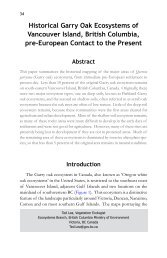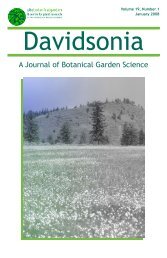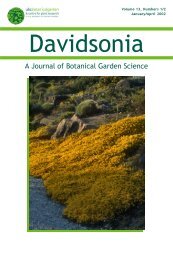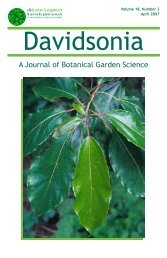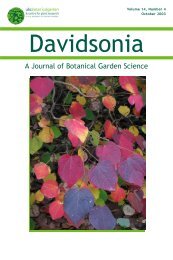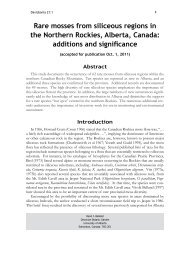Viscin Cells in the Dwarf Mistletoe Arceuthobium ... - Davidsonia
Viscin Cells in the Dwarf Mistletoe Arceuthobium ... - Davidsonia
Viscin Cells in the Dwarf Mistletoe Arceuthobium ... - Davidsonia
- No tags were found...
Create successful ePaper yourself
Turn your PDF publications into a flip-book with our unique Google optimized e-Paper software.
<strong>Davidsonia</strong> 17:3 99<br />
The next step, <strong>the</strong>y posit, is that <strong>the</strong> axis became compressed and<br />
determ<strong>in</strong>ate as C-class genes became negative regulators of <strong>the</strong> meristem<br />
gene, WUSCHEL. Then a petaloid perianth evolved by sterilization<br />
of <strong>the</strong> outer stamens. Baum and Hileman speculate that<br />
this arose by WUSCHEL evolv<strong>in</strong>g a reciprocal regulatory function<br />
for <strong>the</strong> C-class genes. F<strong>in</strong>ally, a dimorphic perianth evolved (calyx<br />
and corolla). This, <strong>the</strong>y suggest, co<strong>in</strong>cides with B-class gene function<br />
becom<strong>in</strong>g dependent on <strong>the</strong> expression of <strong>the</strong> gene UNUSUAL<br />
FLORAL ORGANS (UFO). This model is highly speculative, but as<br />
<strong>the</strong> authors po<strong>in</strong>t out, it fits <strong>the</strong> facts and makes testable predictions.<br />
Kramer (chapter 3) gives a very useful state-of-play review of floral<br />
pattern<strong>in</strong>g by MADS-box and o<strong>the</strong>r genes. The ABC model orig<strong>in</strong>ally<br />
put forward by Coen and Meyerowitz 15 years ago has stood <strong>the</strong> test of<br />
time remarkably well. Elements have been added but <strong>the</strong> orig<strong>in</strong>al core<br />
model has come through <strong>in</strong>tact. As Kramer po<strong>in</strong>ts out <strong>the</strong> more recently<br />
discovered E-class genes could not have been found by <strong>the</strong> orig<strong>in</strong>al<br />
mutagenesis screens because of <strong>the</strong>ir high redundancy. However, our<br />
understand<strong>in</strong>g still relies heavily on Arabidopsis and Antirrh<strong>in</strong>um. Fur<strong>the</strong>r<br />
ref<strong>in</strong>ements will almost certa<strong>in</strong>ly come from <strong>the</strong> <strong>in</strong>vestigation of a wider<br />
range of flower<strong>in</strong>g plants.<br />
Generally, <strong>the</strong> book is timely with excellent quality and good<br />
coverage of <strong>the</strong> subject. If I have one quibble it is with <strong>the</strong> references.<br />
Mostly <strong>the</strong>se are f<strong>in</strong>e. However three chapters (2, 4 and 5)<br />
unaccountably have no titles of articles <strong>in</strong> <strong>the</strong> references. This<br />
<strong>in</strong>consistency makes it hard for <strong>the</strong> reader to judge <strong>the</strong> subject<br />
matter and relevance of this mysteriously title-less cited literature.



